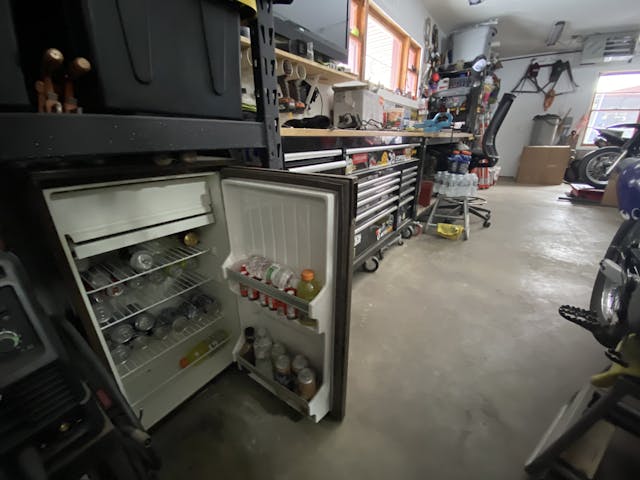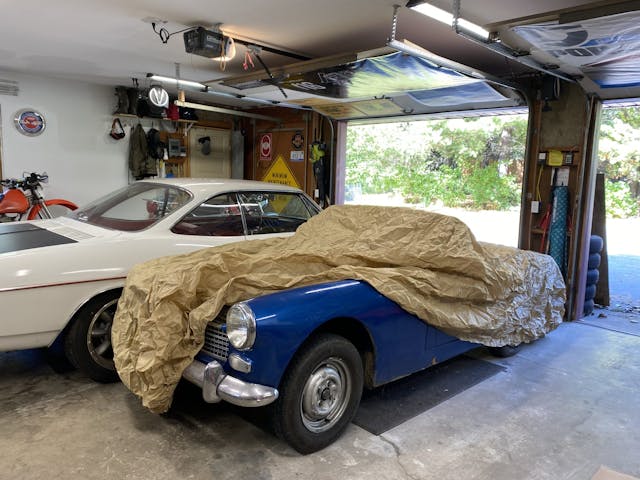Media | Articles
4 Things Silently Killing Your Vintage Car
You click the ignition key one detent to the right. A quick twitch of the right foot to tickle the accelerator pump and set the choke. Another touch on the key and . . .
Nothing.
What should be a crescendo of eight trumpets playing the V-8 version of taps and stirring the car person’s soul awake is instead the painful silence punctuated by the soft click of the ignition cylinder returning to the off position. Wake up, it’s just a nightmare.
At least, for now it is. It could happen to you, though. Nature is a cruel mistress who is conspiring against us and our cars and doing so both vigorously and silently. Here are four main offenders to keep your eye on, since your ears aren’t going to help.
The Garage Fridge

Current moving around inside an electric motor—like the compressor of a refrigerator—produces ozone, and that combined with sunlight can age tires and other rubber parts very rapidly. Replacing dry-rotted but otherwise fine parts gets expensive and annoying very quickly. If you are like me and aren’t ready to give up the fridge or freezer, focus on keeping sunlight away from your vintage ride.
Marketplace
Buy and sell classics with confidence
Corrosion

Deep inside your car, there is a war being waged between materials and nature. Hate to break it to you, but nature always wins. That means rust and other types of corrosion are leaching into the metals and connections that not only shape your car but also make it functional and easily serviceable. For every joke about “hearing a car rust” there are five cars that rusted away before the owner even noticed.
Being Parked

Sitting is the last thing cars were designed to do. All of the silent killers, and a few of the noisy ones, attack when the car is laying dormant. These things gain ground while the car is waiting, only for us to claw back some ground with our occasional drives. Oil coatings slip off and leave dry-start conditions inside an engine that could drive an owner to doing the extra work of priming an engine just to go driving. That’s only for those who are both aware and care enough to take that action. For many, ignorance is bliss when turning the ignition key and hearing the rumble through the exhaust pipes.
Friction

Fine, I’ll concede this one is not always silent, but with or without noise, excess friction is making your vintage car smaller with every drive. I’m not even talking about the intentional friction from brake or clutch lining, but instead about the metal-to-metal contact that was never designed to be that way. Grease and oil are subject to gravity just like us, so keeping oil and grease in the right spot is a never-ending task as they silently slide and ooze past seals and gaskets. One small drop on the garage floor might not seem like a big deal but over time can mean lots of very worn-out parts that seemingly happened out of nowhere.
















This is an impressively bad article, and falls extremely short of the generally high standard that Hagerty keeps. No, a refrigerator does not produce ozone. No, electric current does not produce ozone. How is it that you did enough Google-fu to know that ozone hurts rubber, but not enough to learn where ozone comes from?
Where does it come from?
Mice
And rats and, surprisingly, voles. They can get through openings that would stop a mouse.
The mice are a problem even in a garage. I use peppermint spray to deter them as I have finding acorn remains on my intake manifold or worse yet a chewed up interior. I had one actually chew through the rubber gas vent return line on my car. Made it down the street and the car suddenly stops…oh snap!
Here is what most tire mfgs say.
Store tires away from electric motors, battery chargers, generators, welding equipment, or other ozone-generating sources.
While new fridges have modern motors old still use old style motors. Most garages have old fridges as modern ones die after 10 years. Old will last decades.
The worst damage is sun and heaters with electric blowers that run often. Racing tires are very noted for ozone damage.
Ozone from the refrigerator. That is precisely why I no longer store my tires in the kitchen-like I used to do-before I got married….
Sorry, not buying the ozone from the refrigerator.
I’m sorry, but a garage fridge does NOT produce ozone… it’s a hermetically sealed system, and on top of that it’s an induction motor inside the hermetically sealed system, which wouldn’t produce ozone even if it were running in open air (like the induction motor on your garage air compressor.
Electrical sources of ozone pretty much come down to one thing: sparks. If sparks aren’t being actively produced, neither is ozone. So motors with brushes and commutators DO produce ozone (hand drills, vacuum cleaners, any DC motor or generator on the car itself, like the heater blower, the starter, etc.) But AC induction motors simply don’t, with the very slight exception of the one spark in the switch when the motor turns off or on.
My 40 years of being an electrical engineer and weekend car guy just couldn’t let that one pass. More ozone comes into your garage just from living in an urban area than from all the AC motors you might have in there. So move your garage way out of the city instead of give up the fridge!
Entropy will consume us all. Let’s have some fun in the mean time! 🙂
The best solution for mice I’ve found is to store the car up on the hoist that I don’t use in the winter. I once had them get in the headliner right after i replaced the headliner because mice had gotten in it. Grrr.
I agree with those that mention rodents. I really expected rodents to be at the top of your list. I am a retired auto tech and think rodents likely paid at least a year of my son’s college. I got very used to them staring me in the eye under hood and under dash.
I’ve been driving Air-cooled Volkswagens for going on 50 years. Often–I hear a fellow VW Owner say: “My Carburetor is on the fritz! I can’t drive the car.” OR–“My master cylinder is bad–couldn’t drive to the club meeting today!” I read several of the above comments which emphasize Driving One’s Vintage Vehicle–this is SO important! It’s true–so many of us do NOT drive our vintage vehicles sufficiently. Here’s the two-part “equation” which I’ve developed over the years: One of the following two things will be the first words uttered by the person who fails to drive his vintage vehicle to the monthly Club Meeting: “My brakes are acting up–I couldn’t drive ‘Betsy’ today.” OR–“Couldn’t start ‘Betsey’ today.” It never fails! After the vehicle has sat for weeks-months–it will be the Fuel System OR the Braking System gone bad which prohibits driving. Failure to correct the Fuel System problem will inevitably result in a Brake System problem. Or failure to correct the Braking Problem will result in a Fuel System problem. These two “touchy” Fluid Systems cannot take sitting for lengthy periods of time. So–when I hear a fellow Vintage VW Owner say–“I could not drive ‘Betsy’ today–my Carb is acting up”–I remind that person to quickly correct the Fuel problem BEFORE the Brake System goes bad from sitting even longer.
Yep, brakes and fuel! As you say, the most common results of the “sits”. when i put my cars away for the winter, i use a long hose and a rotary vane electric pump to siphon out most of the fuel in the tank, then transfer said fuel into the daily driver. When spring rolls around, i *have to* put in some fresh fuel. As for brakes, the hydraulics seem to require service/replacement about every 10 years regardless of the miles (just like the tires).
you sure hit those right on the head;
i’ve learned to curse upside down in the dark fluently in several languages;
I use “Just one Bite” bars in every garage space to keep the vermin out of cars and other spaces. They are drawn to the peanut butter smell/taste, then they feast, get thirsty (it makes them thirsty) and they go outside to look for water. They never come back. I’m sure that I’ve purged every home I’ve lived in of hundreds of mice and rats, based on how eaten down the bars get. Stick them under shelves, or in a tight space where the mice can find them, but kids and pets can’t reach. Never fails.
Is you shop fridge from the 1940’s?
Even if it is, your garage would have to be sealed air tight and never opened for 20 years.
The upside it that then your car would be a ‘barn find’
I never knew about the fridge/ozone thing. Never would have thought about it.
Has anyone tried the product “Vamoose” that’s advertised on this site? I live in the woods and mice are a real issue. I like the idea of hood up and lots of lighting. I’m going to go that route but with lighting that has a lesser likelihood of fire. Great advice everyone. This article was very helpful.
I deal with one particular make that has plastic 23 gallon fuel tanks that are almost always parked with minimal fuel, often for decades. What happens is condensation in the large tanks, which makes the engine run poorly, rots the mechanical fuel injection system and rusts the fuel sending units.
Interestingly enough, the main reason that the cars get parked is because they don’t run well because of condensation (parked for long periods with half full fuel tanks), and no knows what the problem is, or wants to fix it. The problem in almost all cases is bad, waterlogged fuel.
The prevention is easy; Park it with the tanks topped up. The fix? Well, get rid of the bad fuel, fuel filter, fill it with fresh fuel and see if it will run. If it doesn’t, then rebuild the fuel system. And, even if you fix it… There are components that are still suffering with rust that will fail down the road…